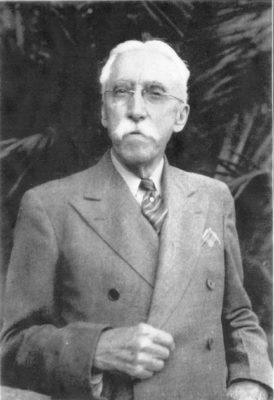Joseph Charles Arthur
by John Dawson

Joseph Charles Arthur, photo from C. G. Lloyd’s Mycological Notes
Arthuriomyces peckianus (Howe) Cummins & Y. Hiratsu is a rust fungus common in the northeastern United States that is a pathogen of black raspberries and other plants of the genus Rubus. Its name is a double eponym, honoring two American mycologists. The specific epithet honors Charles Horton Peck, whereas the generic name commemorates Joseph Charles Arthur (1850–1942), first head of the Department of Botany and Plant Pathology at Purdue University, who founded the rust herbarium there (now containing some 85,000 specimens) that is also named after him.
Arthur was awarded the degree of Doctor of Science by Cornell University in 1886, for a dissertation on fire blight disease of apple and pear.1 He was a member of the first graduating class of Iowa State College (1872), was the first plant pathologist to be hired by a U.S. agricultural experiment station (at Geneva, NY in 1884), and was a charter member of the Botanical Society of America, the American Phytopathological Society, the Mycological Association of America and the American Association of University Professors.
Born 11 January 1850 in Lowville, NY, Arthur grew up and attended country schools in Charles City, Iowa, where his parents, Charles and Ann, moved when he was six. He developed an interest in botany at an early age, but was not encouraged in that pursuit by his parents, who saw no way of his earning a living in that field. Nevertheless, just four years after obtaining his B.S. in botany, Arthur published his first scientific paper (a catalog of Iowa’s flowering plants) and returned to Iowa State as an instructor, where the following year he also earned an M.S. Arthur then studied briefly at Harvard and Johns Hopkins before accepting the offer of an instructorship, first at the University of Wisconsin (1879) and then at the University of Minnesota (1882). Two years later he was appointed to the post at the Geneva, NY experiment station. He was named Professor of Botany at Purdue University in 1887, the year after receiving his doctorate, and retired as Professor Emeritus there in 1915.
Over the course of his career Arthur authored or co-authored 289 articles and books. His last publication appeared in 1936, sixty years after his first, and his magnum opus, the book Manual of Rusts of the United States and Canada, came out two years before that. His mycological work came to an end in 1935 with the death of his wife Emily (nèe Potter), whom he had married in 1901 when he was 51. He himself died in Brook, Indiana, 30 April 1942, aged 92. His papers now reside in the Iowa State University Archives.
In a retrospective overview of Arthur’s life and work,2 his student George B. Cummins describes Arthur’s research as falling into three periods: the first (1872–1884) devoted to “studies of phanerogamic plants”, focusing mostly on the flora of Iowa; the second (1885–1900) to “plant diseases and their control”; and the last and most important (1901–1936) to “life cycles and systematics of the rust fungi”. Highlights of the second period included research on potato scab and corn smut in addition to his work on fire blight, while Arthur’s many contributions to the study of rusts included detailed taxonomic studies of the number and arrangement of germ pores in urediniospores, as well as research on alternate hosts that “led to proof of aecial stages of heteroecious species.”
Cummins notes that though Arthur did “extensive field work” related to his life history studies, he “did little collecting,” relying instead on several other “diligent and discriminating collectors” – especially E.W.D. Holway, with whom Arthur apparently first became acquainted during his years as an instructor at Iowa State.3 Arthur’s association and correspondence with Holway lasted some 48 years, until Holway’s death in 1923.

Joseph Charles Arthur at 87
As a person, Cummins describes Arthur as having been “a gentleman of the old school, dignified, courteous, precise of speech, and careful of grooming; a man of small stature but large presence” — characters fully consonant with the images of Arthur reproduced here.
